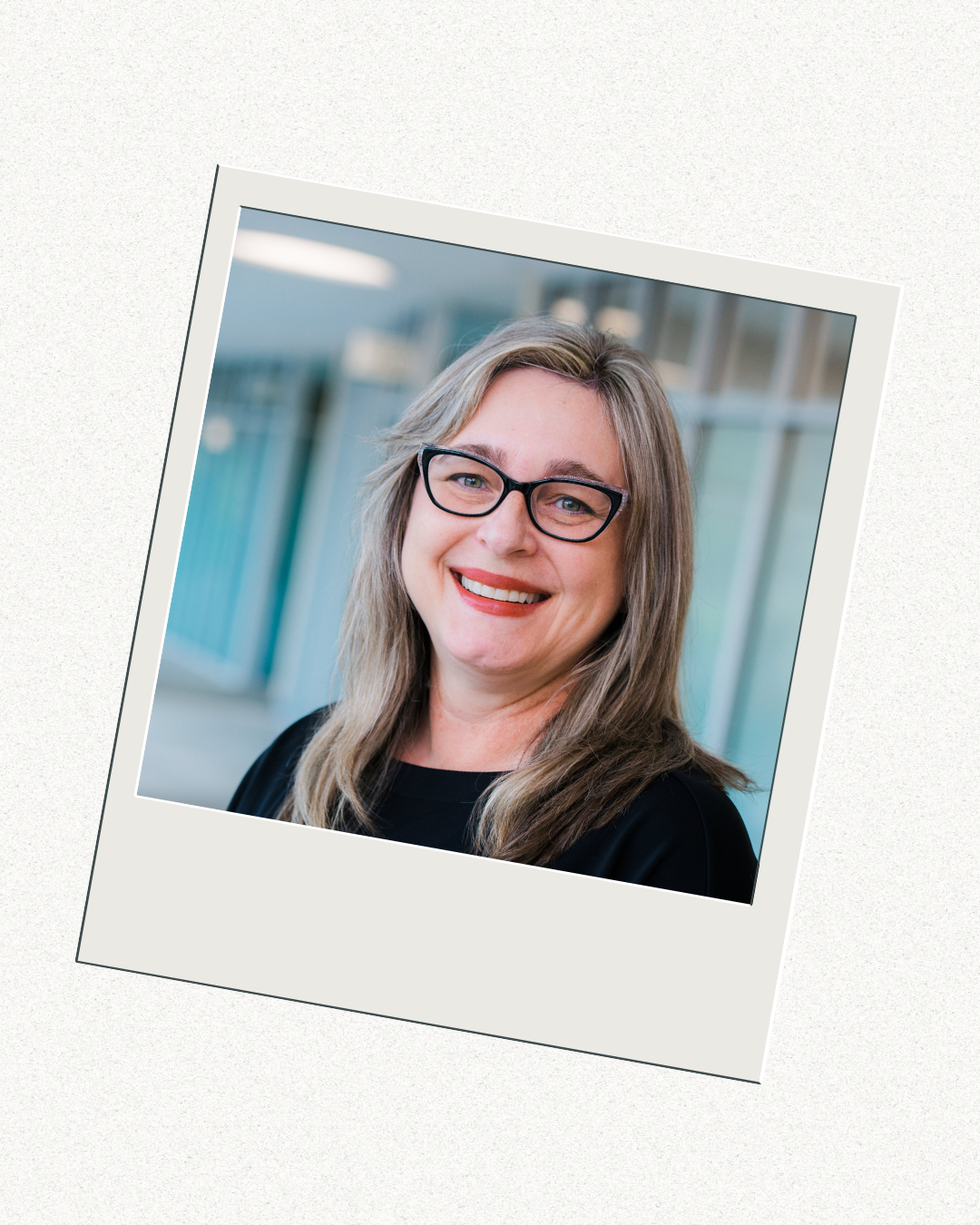#APM19 – Changing Teaching Practices for Technology: Using the SAMR Model for Technology Integration
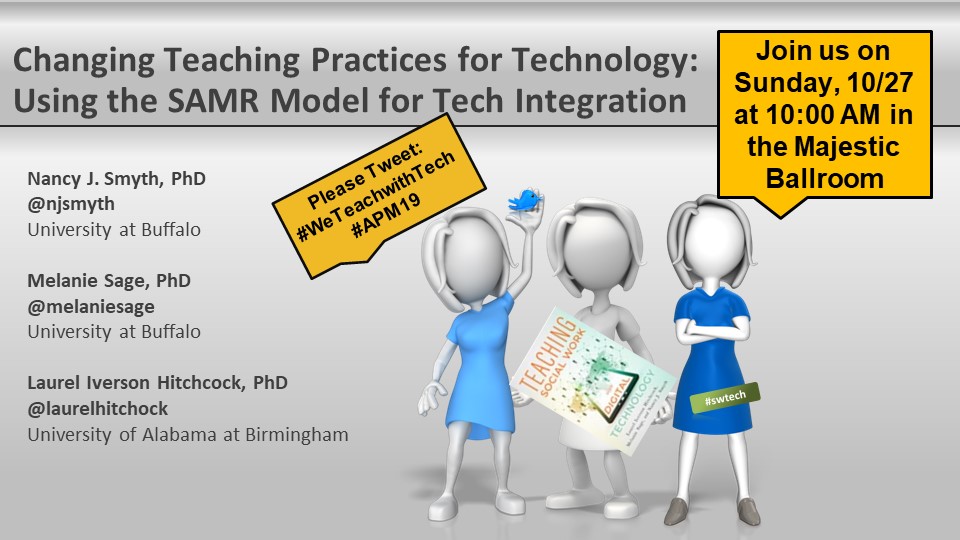
On October 27, 2019 at 10:00 AM, during the Annual Program Meeting for the Council on Social Work Education in Denver CO, Melanie Sage and I will be sharing some insights from Chapter 4 of our book, Teaching Social Work with Digital Technology, co-written with Nancy Smyth. If you are still in Denver, please come find us in the Majestic Ballroom –Tower Building of the conference hotel. We will be sharing how Puentedura’s SAMR Model for Technology Integration can be used to incorporate technology into traditional social justice assignments in social work education. There will also be time to adopt one of your current assignments using the SMAR Model.
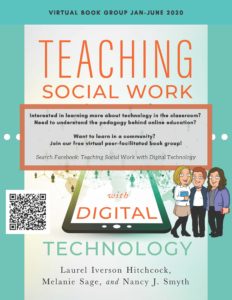
Additionally, we’ll be talking about our virtual book group that will be launch in January 2020. You can read more about it here:
For those of you who cannot make the presentation, we are including the details in this blog post.
#APM19 The Flip(grid) Classroom: Utilizing the Microsoft app Flipgrid to promote student learning
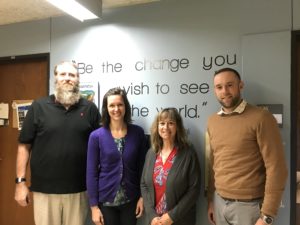
Editor’s Note: In this blog post, I have asked four colleagues from the University at Buffalo School of Social Work to share some information about their presentation at the 65th Annual Program Meeting for Council on Social Work Education next week in Denver, CO. Katie McClain-Meeder, Michael Lynch, Todd Sage, and Margie Quartley will share about their experiences using Flipgrid, a video-based discussion forum, in the social work classroom. In full disclosure, they did ask me to record a video for their presentation, so I may be making a guest appearance during the presentation. Also, you might be interested in reading Todd’s previous blog post about FlipGrid – Incorporating Flipgrid into the Social Work Classroom: Tips for #SocWorkEd.
On October 26, 2019 at 10:30 AM, we (Katie MaClain-Meeder, Michael Lynch, Todd Sage and Margie Quartley from the University at Buffalo School of Social Work) will be presenting an interactive workshop titled The Flip(grid) Classroom: Utilizing the Microsoft app Flipgrid to promote student learning, at the Council on Social Work Education’s Annual Program Meeting. We will be in the Governor’s Square 11 in the Plaza Building.
We know that students are increasingly expecting instructors to utilize new technology to enhance instruction beyond the traditional classroom lecture and content. It is imperative that instructors find meaningful and relevant opportunities to integrate tech into the classroom. Our interactive workshop will introduce you to the video discussion app Flipgrid, which allows students and instructors to quickly and easily interact using short video responses that can be captured via computer or mobile technology. We will highlight case examples, including use for field education, new student orientation, and ways to add depth and breadth to in-person and online instruction.
By attending our workshop, you will learn best practices for introducing and structuring Flipgrid for a variety of educational purposes as well as how to manage Flipgrid from the administrative side, including how to grade, respond and manage discussions. The workshop will also culminate with an opportunity for you to set up their own “grid” with support from us, the workshop instructors.
Conference Presentation: Developing a Professional & Ethical Online Presence for Social Work Practice
On Thursday, October 3rd, I will be at the Alabama/Mississippi Social Work Education Conference presenting with Allison Curington, Field Director at the University of Alabama, about best practices for social workers in the use of social and digital media when working with clients and communities. During this workshop, we will cover the basics of social and digital technologies as well lessons learned from experience with training students and social work practitioners. Additionally, we will be sharing how to access the Social Media Toolkit for Field Educators, a free resource with educator’s guide and a PowerPoint slide deck.
If you won’t be at the conference, I am including all the important details about the presentation in this blog post.
First, you can access your own free copy of the Social Media Toolkit for Field
Educators here:
https://laureliversonhitchcock.org/2018/11/05/revised-social-media-toolkit/
Second, here is a link to a worksheet from the presentation: Develop your Professional Social Media Policy Worksheet
#SWDE 2019 – Imagining Social Work Education into the Future: Skills for Social Justice in a Technology-Mediated World
On April 11th, Melanie Sage, Ellen Belluomini, and I presented at the 2019 Social Work Distance Education Conference in San Antonio, TX on a topic that is beginning to get some traction in social work – the future of social work education for practice with technology. Technology is profoundly shaping the world, especially in the delivery of education. Concurrently, services like telehealth, predictive analytics, and technology aids (i.e. Fitbits, apps and home listening devices) affect service delivery. Given these changes, how do social workers promote social justice and support privacy and equity? And consider needs of the vulnerable while harnessing technology for good? How does social work redefine the profession in the face of algorithmic solutions to human problems? Our goal was to introduce a dialogue about what’s happening, where are gaps in social work education, and how programs might reinvent in a rapidly-changing environment.
If you were not all to make the session or didn’t attend the conference, we are sharing information from the presentation, to make the content more accessible to all and to help promote more discourse among social workers about the future of the profession.
Here are the slides from the presentation:
#SWDE2019 Keynote – What role will Social Workers choose in shaping the digital future?
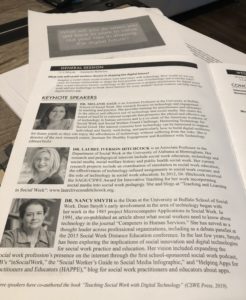
On April 10th, Melanie Sage, Nancy Smyth, and I delivered a keynote speech at the 2019 Social Work Distance Education Conference in San Antonio, TX. We asked social work educators to imagine a world where social workers were innovators with technology. Our goal was to have a conversation and share how we had been talking about technology will writing our book – Teaching Social Work with Digital Technology.
We started our conversation about how social workers could help close the digital justice gap on Twitter, moving from virtual spaces to physical spaces. Many social workers joined in this conversation along the way. We talked about a range of issues from boundary and privacy challenges to accessibility and connection with technology. As Nancy said, “we were near-sighted as a profession. We need to look through the lens of possibilities, not the lens of our fears.”
In this blog post, we are sharing highlights, references, and slides from the keynote. We hope you will help us continue the conversation together and in your places of work and community.
#SWDE2019 – A Toolkit for Social and Digital Media Policies in Field Education
It is the second day of the 2019 Social Work Distance Education Conference and at 10 AM, I’ll be in the Peraux Room of the St. Anthony Hotel to share our poster about the Social Media Toolkit for Field Educators. This is a project I have been working on with Allison Curington (University of Alabama), Mary Jacque Carroll (University of Alabama at Birmingham),and Robin Snider (Jacksonville State University). The poster will provide both information and tools that field directors can use to guide curricular development of learning approaches and assessment strategies to achieve practice outcomes. Participants will learn how to access the Social Media Toolkit for Field Educators, a free resource with educator’s guide and a PowerPoint slide deck.
If you can’t make it to the poster, I am included all the important details in this blog post.


